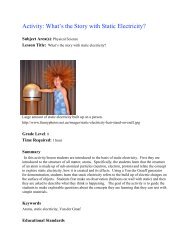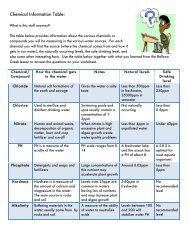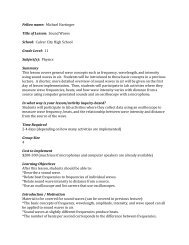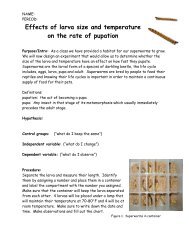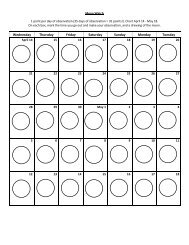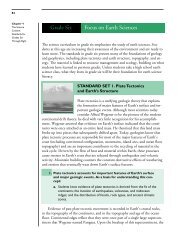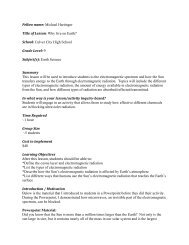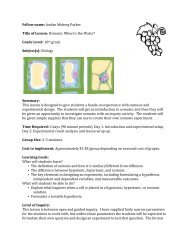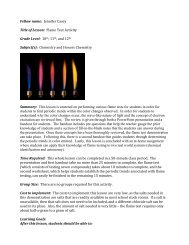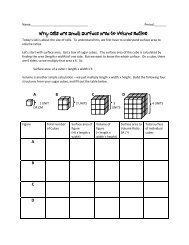Fellow name: Cam Macris Title of Lesson: The Inquiry Based Crayon ...
Fellow name: Cam Macris Title of Lesson: The Inquiry Based Crayon ...
Fellow name: Cam Macris Title of Lesson: The Inquiry Based Crayon ...
Create successful ePaper yourself
Turn your PDF publications into a flip-book with our unique Google optimized e-Paper software.
<strong>Fellow</strong> <strong>name</strong>: <strong>Cam</strong> <strong>Macris</strong> <br />
<br />
<strong>Title</strong> <strong>of</strong> <strong>Lesson</strong>: <strong>The</strong> <strong>Inquiry</strong> <strong>Based</strong> <strong>Crayon</strong> Rock Cycle <br />
<br />
Grade Level: 6 th <br />
<br />
Subject(s): Earth Science <br />
<br />
<br />
<strong>Crayon</strong> shavings representing weathered rock. <br />
<br />
Summary: <br />
<br />
This activity is a hands‐on introduction to the rock cycle using crayons. <strong>Crayon</strong> wax has the <br />
ability to broken into small pieces (weathered), heated, cooled, and compressed much like <br />
rocks. We will safely simulate the rock cycle and the processes that form and change rocks. <br />
Using crayons and some other common items, the students will create sedimentary, <br />
metamorphic, and igneous crayon rocks. <br />
<br />
Time Required: <br />
55 minutes <br />
<br />
Group Size: <br />
Six groups <strong>of</strong> six or so students <br />
<br />
Cost to implement:
~ $50 <br />
<br />
Learning Goals: <br />
After this lesson, students should be able to: <br />
1) Describe and/or demonstrate how any type <strong>of</strong> rock can become any other type <strong>of</strong> rock. <br />
2) Draw a diagram <strong>of</strong> the rock cycle. <br />
3) Describe the processes that form each type <strong>of</strong> rock. <br />
<br />
Introduction / Motivation: <br />
<br />
<strong>The</strong> students should already have been introduced to the different types <strong>of</strong> rocks and <br />
should have a general background on the rock cycle. <strong>The</strong> teacher should have large <br />
samples <strong>of</strong> each rock type to show the students. <strong>The</strong>y are going to make their own rocks <br />
today ‐ crayon rocks, that is! <strong>The</strong>y are going to speed up the rock cycle and simulate <br />
processes that form rocks deep in the earth. <strong>The</strong>y each start with an ‘igneous crayon’ and a <br />
set <strong>of</strong> tools on a tray. <br />
<br />
Procedure: <br />
<br />
Make a sedimentary crayon: <br />
1. Ask the students how sedimentary rocks are formed from igneous rocks. <strong>The</strong>y <br />
should answer that the igneous rocks are weathered and eroded to form <br />
sediments, which are then deposited, buried, and compacted to form <br />
sedimentary rocks. <strong>The</strong>n ask them how they can use the tools in front <strong>of</strong> them <br />
(pencil sharpener, plastic knives, popsicle sticks) to create sediments. Allow <br />
them to discuss with the group their ideas, then allow them to experiment with <br />
their ideas. After they create a pile <strong>of</strong> ‘sediments’, remind them to pick up the <br />
sediments and move them to simulate erosion. <br />
2. Ask the students what they can do with their sediments to deposit and compact <br />
them? <br />
3. <strong>The</strong>y should come up with the idea to drop sediments into the wax cupcake cups <br />
and fold into a packet to simulate deposition. <br />
4. Apply pressure to the packet by pressing down on it to simulate compaction. <br />
5. Open the packet and observe your sedimentary crayon. <br />
6. Take a moment to begin drawing the rock cycle using what the students just <br />
simulated to go from an igneous rock to a sedimentary rock. <br />
<br />
Make a metamorphic crayon: <br />
1. Ask the students how sedimentary rocks become metamorphic rocks. Now ask <br />
them how they can simulate those processes using the tools in the classroom. <br />
Guide them to place a small pile <strong>of</strong> sedimentary, metamorphic, or igneous <br />
crayons into an aluminum foil cupcake cup. <br />
2. Float this foil on hot water and watch as heat from the water transfers to the foil <br />
and to the crayons.
3. <strong>The</strong> crayons will start to melt, but remove the foil from the heat source when the <br />
wax is s<strong>of</strong>t to the touch (use a popsicle stick to probe, not your finger). Don’t <br />
allow the wax to melt completely. <br />
4. As the wax cools you may choose to again apply pressure to simulate <br />
metamorphism by partial melting and pressure. <br />
5. Open the packet and observe your metamorphic crayon. <br />
6. Take a moment to add these processes to your rock cycle. <br />
<br />
<br />
<br />
Make an igneous crayon: <br />
1. Ask the students how metamorphic rocks become igneous rocks. Now ask them <br />
how they can simulate those processes using the tools in the classroom. Guide <br />
them to place a small pile <strong>of</strong> sedimentary, metamorphic, or igneous crayons into <br />
an aluminum foil cupcake cup. <br />
2. Float this foil on hot water and watch as heat from the water transfers to the foil <br />
and to the crayons. <br />
3. <strong>The</strong> wax should be allowed to melt until a smooth liquid forms. <br />
4. Observe your igneous crayon form as the melted liquid cools. <br />
5. Complete the rock cycle diagram. <br />
<br />
<br />
<br />
Materials List <br />
Each group will need: <br />
‐enough crayons for each person to get at least one <br />
‐a couple <strong>of</strong> pencil sharpeners, plastic knives, or other grating utensils <br />
‐a Styr<strong>of</strong>oam cup or bowl <br />
‐enough foil and wax cupcake cups for each student to get one <br />
<br />
To share with the entire class: <br />
‐source <strong>of</strong> hot, but not boiling water <br />
<br />
<br />
Safety Issues: <br />
<strong>The</strong> students will be working with hot water, so they should be instructed to be careful. <br />
<br />
<strong>Lesson</strong> Closure: <br />
<br />
Ask the students how they could make their igneous crayon into a metamorphic crayon, <br />
then ask them how to make that into a sedimentary crayon. <strong>The</strong> point is that they realize <br />
that any rock can become any other type <strong>of</strong> rock. <br />
<br />
Is this lesson based upon or modified from existing materials? If yes, please specify <br />
source(s) and explain how related: <br />
This lesson is based on modifying and combining a couple <strong>of</strong> online lesson plans also <br />
entitled “<strong>The</strong> <strong>Crayon</strong> Rock Cycle”. <br />
<br />
References: <br />
http://www.mysciencebox.org/crayonrock <br />
http://www.exo.net/~emuller/activities/<strong>Crayon</strong>‐Rock‐Cycle.pdf <br />
http://www.mysciencebox.org/book/export/html/232 <br />
<br />
<br />
List CA Science Standards addressed: <br />
Grade 6 <br />
1. Plate tectonics and earth’s structure <br />
a. Students know evidence <strong>of</strong> plate tectonics is derived from the fit <strong>of</strong> <br />
continents; the location <strong>of</strong> earthquakes, volcanoes, and midocean ridges; and <br />
the distribution <strong>of</strong> fossils, rock types, and ancient climatic zones. <br />
2. Shaping earth’s surface <br />
b. Students know rivers and streams are dynamic systems thate erode, <br />
transport sediment, change course, and flood their banks in natural and <br />
recurring patterns. <br />
<br />



